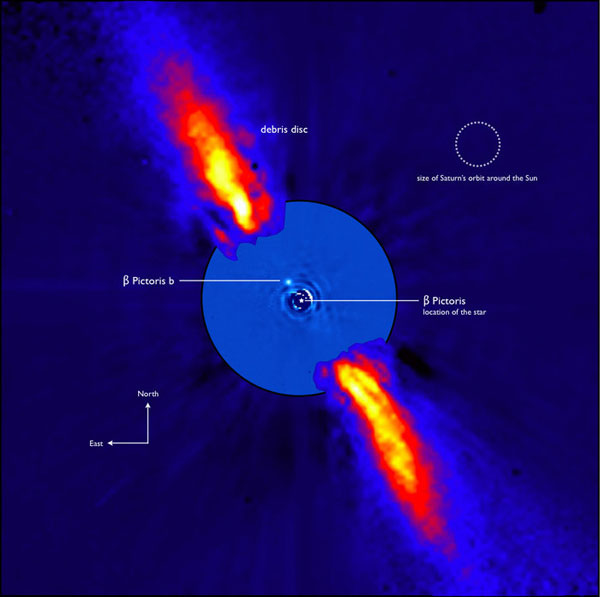Astronomers have a precise new mass measurement for Beta Pictoris b, a young gas giant still in the throes of formation 63 light-years from Earth.
Astronomers Ignas Snellen and Anthony Brown (both at Leiden University, The Netherlands) have used precise stellar measurements from space to “weigh” Beta Pictoris b, the young and massive planet that was famously imaged around a nearby star.

ESO / A-M. Lagrange et al.
Discovered in 2008, the young gas giant still radiates heat leftover from its formation as it orbits Beta Pictoris, a 20 million-year-old star about 63 light-years away. Astronomers directly imaged the planet at infrared wavelengths using the Very Large Telescope at the European Southern Observatory in Chile. As one of the youngest directly imaged planets, Beta Pictoris b may provide information on the formation of gas giants such as Jupiter, giving us a glimpse back to the early stages of our own solar system.
But astronomers have been struggling to understand the planet’s detailed properties over the last decade. The mass of Beta Pictoris b has been especially difficult to estimate. Astronomers first suspected the planet existed due to its influence on the star’s large debris disk. From those early hints, estimates suggested any planet would have several times Jupiter’s mass. But once astronomers had directly imaged Beta Pictoris b, mass estimates ranged from 4 to 17 times Jupiter’s mass.
Now, Snellen and Brown have used the exquisite positional data of the Hipparcos and Gaia missions to measure the star’s motion in space, estimating its planet’s mass to be between 9 and 13 Jupiters. The work appears in Nature Astronomy. Unlike previous measurements, the new result doesn’t depend on assumptions about the star or disk. Instead, Snellen and Brown measure only the planet’s gravitational tug on its host star. Radial velocity detection techniques rely on the same gravitational pulls, but with positional data, we can actually observe the star carving out small wiggles in the night sky.
Estimating the mass of Beta Pictoris b is important for understanding how planet formation works generally. Since tracking the evolution of a single solar system would take billions of years, astronomers study planets around stars of different ages to get snapshots at different stages of formation. While there are many observations of disks that have yet to form planets, and thousands of known planetary systems, the number of known still-forming planets is relatively small. Beta Pictoris b provides a vital data point in understanding how young gas giants accumulate gas and dust.
Measuring the star’s minute movements also enabled Snellen and Brown to estimate the planet’s orbital period. The period is at least 22 years or longer, confirming the planet’s distance, which was thought to similar to Saturn’s distance from the Sun based on direct imaging data.
While this is one of the first planets whose mass astronomers have estimated using Gaia data, it won’t be the last. In the coming years, Gaia will provide the data needed to discover hundreds to thousands of planets using the same method, unlocking a new window of planetary discovery in our galaxy.
 0
0









Comments
You must be logged in to post a comment.